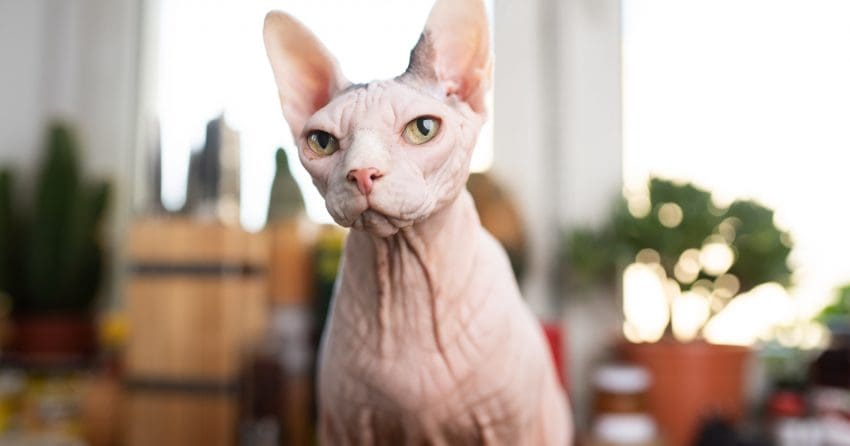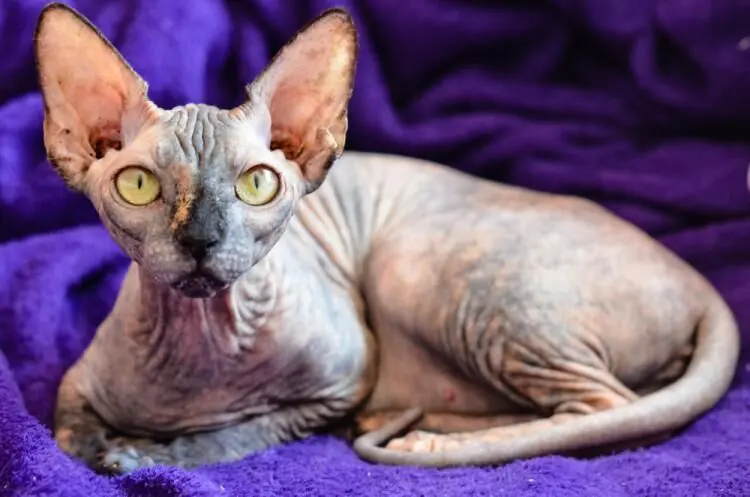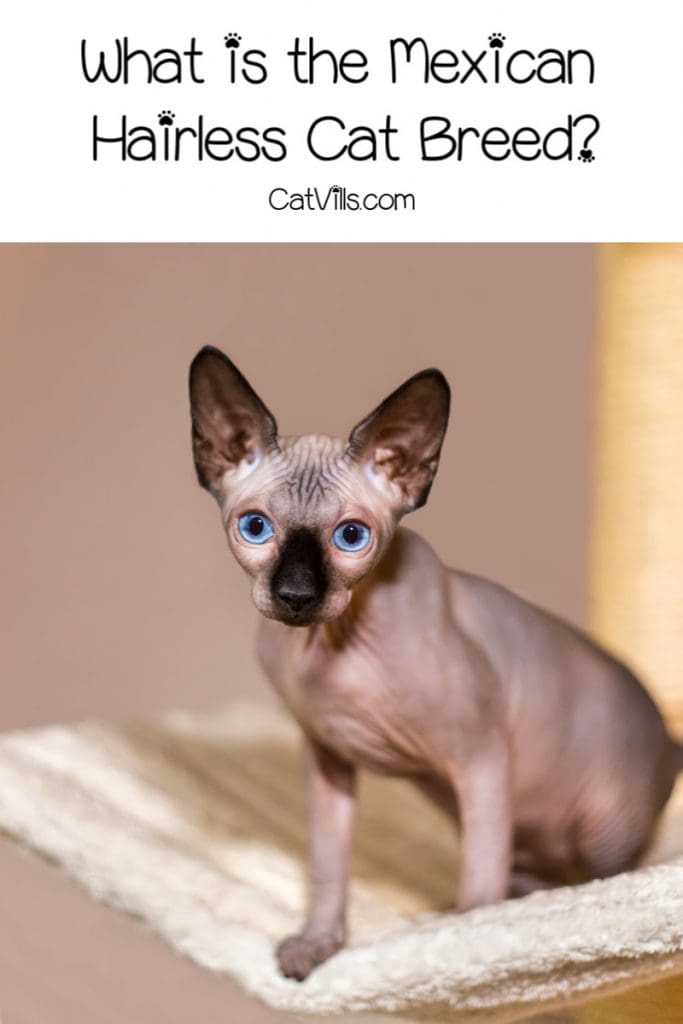Last Updated: 5 months ago
Have you ever heard about the Mexican cat breed, also known as the Mexican Hairless cat?
You probably haven’t, or you might think that it’s one of those new exotic cat breeds.
Well, keep on reading to find out more about these hairless cats, where they come from, and what they’re like.
What Is the Mexican Hairless Cat Breed?

When I say “hairless,” most of you think about Sphynx cats.
However, the Sphynx isn’t the only hairless cat breed in the world, just the one that makes the news.
Besides the Sphynx, other hairless breeds include the Bambino, Peterbald, Donskoy, and Ukrainian Levkoy.
But it all comes back to the Mexican hairless cat.
Don’t feel bad if you’ve never heard about the Mexican cat breed or seen cute pictures of it.
It’s a supposedly extinct breed that was documented in the early years of the 20th century.
Where Does the Mexican Hairless Cat Breed Come from?
One of the earliest reports of hairless cats dates back to 1878, when two kittens were born to a short-haired cat.
While they were a novelty, their appearance didn’t cause much of a sensation. However, in 1902, hairless cats made the news.
As the story goes, the Pueblo people gave two hairless kittens to a couple from New Mexico. The Puebloans claimed that the kittens were the last of an ancient Aztec cat breed.
Mr. Shinick, the owner of the cats, said that the cats were littermates and that they were smaller than the local short-haired cats.
He described that the cats would grow fur on their backs and tails during the winter and that the female, Nellie, had long eyebrows and whiskers.
The owner also mentioned that the cats liked to sleep beneath the bed covers and that they were some of the most affectionate cats he had ever seen.
Per his word, the cats seemed to understand almost everything he said, and they were always warm to the touch.
Unfortunately, the male, Dick, died quite young after a confrontation with dogs. Nellie, the female, lived to be 15 years old.
Apparently, her body was preserved in the Museum of Natural History at the Smithsonian Institute in Washington until it was lost.
Since the two cats were littermates, Mr. Shinick never attempted to breed them, and there were no hairless kittens born to continue this ancient Aztec breed.
Due to the popularity of these two hairless felines, people used the names Mexican Hairless Cat, New Mexican Hairless Cat, and Aztec Cat to describe them.
That practice continued until the 1930s, when a French cat gave birth to hairless kittens.
How much of that story is true is hard to say. Likely, the Aztec part of the story was invented to make the cats sound exotic and attract the attention of the public.
But stories about hairless cats go back to Aztec times, so the Aztecs might have had such cats.
How Did the Sphynx Appear?

Since Mexican hairless cats were a rare event, people didn’t make any conscious efforts to mate with them until the 1960s.
It all happened when a hairless kitten (Prune) was born in Toronto to a black and white shorthair cat.
The owner fell in love with the appearance of the kitten and decided to reproduce Prune and mate him with his mother.
Later on, another cat breeder from Ontario found three hairless kittens abandoned on the streets and sent them to the Netherlands.
These kittens were bred successfully to a Devon Rex. Wadena, Minnesota, greatly contributed to the hairless cats’ breeding program.
Milt and Ethelyn Pearson noticed that their domestic shorthair cats often had hairless kittens. They sold some of these kittens to breeders who crossed them with Cornish Rex.
It wasn’t easy in the beginning because the gene pool was tiny and the breeders had very little information about the genetics of these hairless cats.
Unfortunately, a lot of kittens didn’t survive, and some had severe health problems.
However, the breeders’ efforts paid off, and the new breed was known at first as the Canadian Hairless Cat, not the Mexican hairless.
Later on, these unique cats were given the name Sphynx after the impressive Egyptian statue and the mythical creature from Greek legends.
Why Are Hairless Cats Hairless?
Sphynx cats aren’t completely hairless. They have very short, fuzzy hair, and that’s why they look bald.
What causes it is a mutation in a gene called keratin 71 (KRT71).
This gene is responsible for producing hair follicles, and its mutation damages the structure of the cat’s fur.
While hair can still form, it falls easily. That’s why Sphynx cats have short, fuzzy hair instead of a short/long coat.
The Sphinx’s mutated gene is close to the one that determines the Devon Rex’s short coat and the curly fur of the Selkirk Rex.
That’s why breeders were able to produce hairless kittens by crossing them with Devon Rex. It’s also a recessive gene, which means that it’s inferior to the other hair genes.
That’s why you might have furry kittens if you breed the Sphynx with other breeds (not that you should try it).
How much is a Mexican hairless cat

Buying a Hairless Mexican cat costs between $75-$100, whereas buying one from a breeder can be as much as $1,000.
How to Care for Mexican Hairless Cats?
No matter what hairless cat you have at home, caring for such cats is slightly different than caring for normal, furry ones.
For once, hairless cats are prone to chills because they don’t have short or thick coats to protect them from the elements.
You’ll need to maintain their body temperature, dress them up, or provide heating blankets in winter. Besides being sensitive to cold, Sphynx cats also easily overheat.
As such, you have to keep an eye on them on hot and humid days and keep them cool.
The lack of fur also means that hairless cats can burn in the sun and have more sensitive skin than ordinary cats.
Moreover, hairless cats require even more grooming than some long-haired ones. That’s because you have to bathe your cat often, or they get smelly.
You also have to dry them thoroughly to prevent bacteria overgrowth, feed them high-quality food, trim their nails, clean their ears, and wash between the toes.
It’s a lot of work, so consider yourself warned. You also have to keep in mind that purebred cats, such as the Sphynx, are prone to some diseases.
As such, you should get your cat from a respectable breeder who tests for hereditary conditions.
If you’re thinking about getting any hairless cats, you should know that a lack of fur doesn’t mean that the cat is hypoallergenic.
It’s the amount of danger that triggers allergies, not how much fluff they have. So, the Sphynx might not be the best cat breed for people with allergies.
It’s funny to think that people who used to practice human sacrifices bred and took care of hairless cats hundreds of years ago.
And while Mexican Hairless cats might be extinct, they’ve inspired people to create the Sphynx and other hairless cat breeds.
References:


Olfa knows how to get things done and has a keen business sense that others admire. She’s always on the go, coming up with new ideas! Her ability to anticipate the needs of her readers and deliver information that they want is what makes CatVills such a success. She loves cuddling her cat Picaciu. He is her inspiration.

Those cats have amazing eyes 🙂
My daughter has been obsessed with hairless cats. She wants one as our next pet. Thanks for this article.